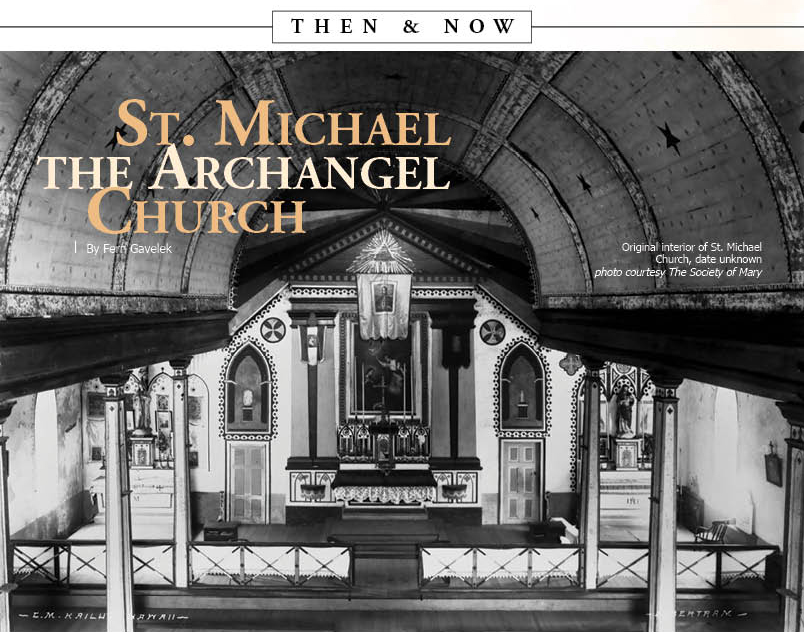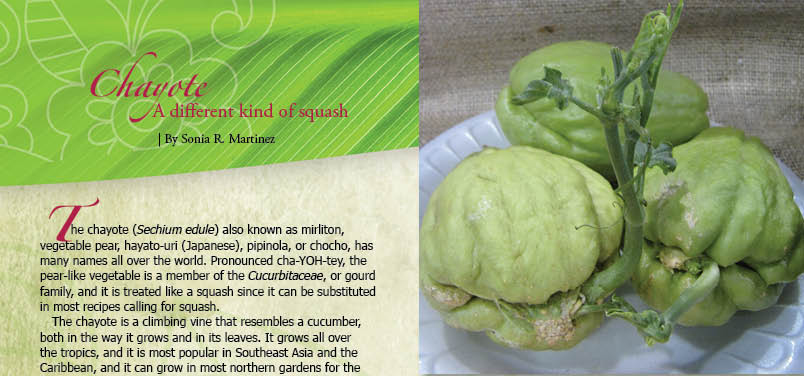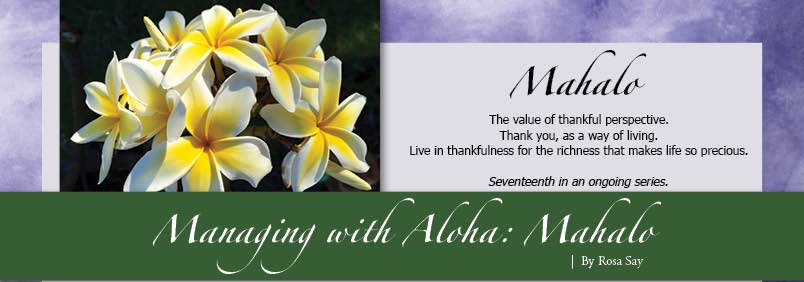
Then & Now: St. Michael the Archangel Church

By Fern Gavelek
An 1855 landmark that housed North Kona’s Catholic community for more than 150 years, the original St. Michael the Archangel Church was damaged beyond repair during the October 2006 earthquake. A new church, reminiscent of the old was erected in March in the original building’s footprint and dedicated to a beaming crowd of 1,500 faithful.
How both of these buildings came to be is a story of faith, and also one of perseverance demonstrated by a string of clergy and six generations of parishioners.
The history of St. Michael’s begins in 1840, when two French priests arrived in Kailua-Kona from O‘ahu to bring Catholicism to Hawai‘i Island. The optimistic and hard-working members of the Fathers of the Congregation of the Sacred Hearts of Jesus and Mary overcame a score of challenges to pave the way for the founding of St. Michael the Archangel mission. Today, a stone hitching post inside the Kona Plaza Shopping Arcade marks the location of the island’s first Catholic Mass.
The French-based priests came to Kailua-Kona after facing strong Protestant opposition on O‘ahu. However, the Religious Tolerance Act passed in 1839 by King Kamehameha III, Kauikeaouli, paved the way for their welcome in Kailua-Kona.
An American national named “Amala” befriended the two Palani (French) priests—Rev. Robert Walsh and Rev. Ernest Heurtel—and gave them a place to stay. They soon met Governor John Adams Kuakini, who invited the missionaries to reside in the late Queen Ka‘ahumanu’s vacant house, which was located just south of today’s Moku‘aikaua Church.
Outside the house, the priests built a tiny, “native-style” chapel with a white cross above the entrance and celebrated Hawai‘i Island’s first Catholic Mass on July 5, 1840. Kuakini, who had recently built Hulihe‘e Palace and Moku‘aikaua Church, soon offered the priests a piece of land to build a church and school—the present location of St. Michael Church.
By the end of 1841, 655 Catholics were recorded to have been baptized in Kailua-Kona, with missions set up in Waimea, Hilo, and Puna. According to North Kona’s Catholic Heritage…Remembered, Kuakini grew close to the medically adept Rev. Heurtel, who often cured the aging governor. The priest convinced Kuakini to build him a larger church on the recently gifted church grounds and a school was added.
In addition to ministering and doctoring Kona residents, Rev. Heurtel traveled around the island to oversee new priests. Pioneers of Faith describes a typical journey as “climbing up and down the slopes of Mt. Hualalai on a narrow trail, scaling the Kohala mountains and wading through the gulches…All along the roads and trails there were hamlets of Hawaiians eagerly awaiting the visit of the priest—sick to be attended to, children to be baptized and catechumens to be instructed.”
In 1844, Rev. Heurtel was instructed to plan a new, permanent St. Michael Church. The project progressed slowly, and due to deteriorating health, the pastor asked to be relieved of his duties. Rev. Joachim Marechal was then tasked with the Kona flock and its building project. According to Hawaii’s Missionary Saga, Rev. Marechal “was a powerful, active and attractive leader who won people’s respect, confidence and support.” He wholeheartedly went about constructing the church and recruiting volunteers from “all the Catholic communities of Kona, assigning to them a monthly quota of building materials such as lime, lumber and stones.”
With few skilled laborers at his command, it took the priest two years to build the original St. Michael Church. It measured “a depth of 22 yards by 14 yards in width” and the sanctuary was another seven yards deep. Considered among the isle’s best buildings of its time, the church was a stone structure of lava rock and coral sand mortar. The floor was hard-packed dirt. The second floor housed a small living quarter for priests and a bell, gifted from France, tolled from a tower at the building’s mauka end. The church was dedicated in 1855 and during that same year, Rev. Marechal recorded the “2,654th baptism in the Konas.” Four years later, the 45-year-old priest died and was interred beneath the church he labored to build.
With St. Michael Church completed, succeeding Kailua-Kona pastors turned construction efforts toward building St. Michael’s four mission churches. St. Paul’s at Kawanui (Honalo) in 1864 was patterned after St. Michael’s, the A-frame-style Holy Rosary Church at Kalaoa in 1874 and Church of the Immaculate Conception in Hōlualoa in 1880. Tiny St. Peter’s by the Sea was first erected near La‘aloa Beach in 1880 and later moved in 1912 to its present Kahalu‘u location adjacent to Ku‘emanu Heiau. These smaller mission churches catered to Kona’s farming communities and are still in operation today as part of St. Michael’s Parish.
Fast forward to 1940 when Rev. Benno Evers led a team of youth to build St. Michael’s outdoor Coral Grotto for the island’s Catholic Centennial Celebration. Residents dove off the Kona coast to collect 2,500 pieces of coral to fashion the grotto over the site of Kailua Village’s original well. The grotto became a popular Kailua Village landmark and photo opportunity for visitors.
In 1955, a wooden convent with a chapel was dedicated on St. Michael’s grounds. The Sisters of the Holy Family (SHF) nuns were recruited to teach religious instruction. One of them wrote in the SHF newspaper, “The school bells have not yet rung out in the Kona area as our children are busily engaged in coffee picking…yet four sisters are ready to begin house visitation and encourage their little ones to attend Sunday Mass.” The sisters served Kona parishioners until the mid-1990s and the former Kailua convent was later repurposed into the parish administration building.
Other dates chronicling the original church’s history are 1968, 1974, and 1982 when the stone structure suffered extensive ocean flooding. In 1993, parishioners and clergy transformed the dirt parking area into a paved lot with 80 parking spaces. The church grounds were landscaped, and the beautification earned St. Michael’s a 1995 Kona Outdoor Circle award. Next, the church’s interior was spruced up with a new altar, pews, statuary, and flooring financed by parishioners. Kona artists were commissioned to craft several stained glass windows; each depicted a different meaningful story for parishioners.
“Our priests during the 1990s were persuasive in their homilies and gifted in raising money for whatever we needed to do church improvements, both inside and out,” remembers Susan Bender, long-time church office manager. “We enjoyed these many improvements for a decade before the earthquake.”
On the morning of October 15, 2006, a 6.7 earthquake rocked Hawai‘i Island, damaging buildings old and new. The structural engineering firm of MKM & Associates deemed the church unsafe, noting the church’s disintegrating structure—caused by past flooding and age—could not be effectively repaired. Sadly, St. Michael’s was permanently closed and worship moved to a large tent on the church grounds.
“After the church was closed, I felt like the Biblical Israelites wandering in the desert, looking for a place to pitch a tent and make a permanent home,” says Rev. Konelio Faletoi, known fondly as “Father Lio.” The current pastor of St. Michael’s faced the enormity of replacing the parish’s main facility that served nearly 2,000 families and a steady stream of visitors.
A native of O‘ahu, Father Lio said the first challenge in replacing the church was bringing parishioners together to decide what to do. “Some wanted the church to be one way, others differently,” he explained. “A design was approved to keep the historical integrity of the original church,” Father Lio shared. “At the same time it addressed the needs of our growing congregation.”
While St. Michael’s wasn’t listed on any official registrar of historic places, it was more than 50 years old and so a report was required to document its structural attributes before it could even be torn down. Acquiring a demolition permit was the first of many permits and lengthy studies that had to be obtained. “We worked with numerous agencies and organizations,” Father Lio recalled. In addition, the church’s location in a flood zone, a special management area, and the Kailua Village Business Improvement District also presented additional requirements and approvals. Experts analyzed everything from soil to resident bird life and completed a string of reports covering burials, archeology, Hawaiian culture, traffic noise, and more.
Meanwhile, a parish pledge drive kicked off to construct the new church campus. Finally, on November 2, 2009, the 1855 church was decommissioned in a special ceremony and then demolished. An archeologist located the interred remains of Rev. Marechal, which were put in a safe place to be re-interred under the new building. The termite-ridden former convent building was also subsequently torn down and administrative offices were temporarily moved to the parish hall at Immaculate Conception in Hōlualoa.
Parishioners thought a groundbreaking ceremony on September 28, 2012 signaled the physical beginning of the new St. Michael’s—until the chosen general contractor unexpectedly rescinded the job. “It took a few months to again go through the bidding process but another contractor was secured and then work began in earnest,” detailed Father Lio. “Site preparation presented some unexpected challenges and that also lengthened completion time.” During excavation, workers uncovered the 1841 church’s footprint, which ran north and south, and unearthed an antique aspergillum, a liturgical implement used to sprinkle holy water.
With construction in full swing on church property, parishioners had moved the large worship tent to a vacant lot at Honokohau Industrial Park. Congregants pitched in to make the facility comfortable and attractive, using hundreds of chairs and carpeting provided by local hotels. Parishioners also brought plants, and the tent’s interior was gaily decorated during holidays. “Visitors came and marveled at how nice it was there,” smiles Father Lio. “We were very blessed.”
All the hard work paid off when the newly constructed St. Michael the Archangel Church was dedicated March 25.
A throng of 1,500 faithful jubilantly packed the newly hewn pews and spilled out on to the side lānai. Many of the congregants expressed tears of joy and an overwhelming sense of “coming home” filled the church.
While the new church shares the same exterior profile and pale pink color as the 1850s church—complete with the bell tower—it is larger, measuring 9,500 square feet to seat 630.
“We also incorporated several elements from the original church inside the new one,” details Father Lio.
A baptismal font sculpted from a large piece of West Hawai‘i lava greets the faithful. It is surrounded by mosaic tiles etched with words that appeared over the altar of the original church: E Ku‘u Keiki: E Ho Mai No‘u Kou Pu‘uwai A E Ike Oe I Ku‘u Alahele-The Lord Says to Thee: Give Me Thy Heart and Let Thine Eyes Keep My Ways.
“Having the font at the entrance of the church reminds all who enter that it is in the waters of baptism that Christian life begins,” explains Father Lio.
A floor tombstone near the altar marks the new resting place for Rev. Marechal. Behind the main altar is a private adoration chapel, and its outside doors are graced with two of the 1996 commissioned stained glass windows; they are brilliantly illuminated in the morning sun. The other two windows will be installed in the church’s future two-story parish center that will house a commercial kitchen, office, gift shop, and meeting rooms; its footings are already in place on the south side of the church.
The front of the new St. Michael’s is elevated 21-feet to meet building code requirements, and the entrance is accessed via two semi-circular stairways. Cradled between the stairways is the restored, fresh water well that was historically used by the Kailua community. The landmark coral grotto was moved to front the future parish center.
“The well has been preserved to serve as a central feature in the outdoor Waikūpua Brick Garden,” adds Father Lio. “We invited parishioners and the community to become part of the history of St. Michael’s by sponsoring a brick in the garden. (see story here)
Local artisans crafted the church’s new altar, ambo (pulpit), and presider’s chair, while a local woodworker completed cabinetries in both sacristies. Hanging above the altar is a beautiful, 16-foot crucifix that was carved in Peru.
“Assembling and mounting the crucifix was like saying a prayer; it was a very spiritual experience,” Father Lio shared.
He concluded, “We thank all who donated their time, talent, and treasure, and we continue to believe our most important asset is the faith of our members who continue to carry Christ to the community and its less fortunate persons.”
St. Michael’s has an ongoing Capital Campaign to pay off construction debt and build the future parish center. ❖
Contact St. Michaels: 808.326.7771
Readers wanting more historic information on all of St. Michael’s five churches can purchase a copy of the parish’s 2009 book, North Kona’s Catholic Heritage…Remembered.
Contact the writer


